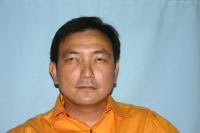As for myself, I brought along my portable imaging setup which includes a Canon EOS 500D DSLR with Canon EF 100-400mm f/4.5-5.6 IS L Lens on Kenko Sky Memo-R mount. This will be my real first attempt to do any DSO imaging with this setup as I'm more used to using my venerable TV-101 refractor on Vixen GP-DX mount. But since my family came along with me to the event. I had to leave my standard imaging setup at home and just carry along the above setup for more room space in my car.



As darkness falls, I started to polar align through the Sky Memo which uses a different format for polar aligning to the North Pole. I had to turn the polar scope dial through the orientation of the Big Dipper position in the sky and try to put Polaris in one of the 2 slots with he other star designated Delta Ursa Minori which to be honest is quite hard to see through the red recticle even at its lowest dim setting. I had to turn off the recticle to see where it is and then turn it on again to slightly fine tune the 2 stars into the 2 designated slots/ Alas, after using more than 15 minutes of my time. I got to polar align my mount!
Unfortunately, Orion is setting a bit low into the western horizon already thus I had to let go of my target which is the Horsehead Nebula in Orion :( I tested a few 3 minutes frame but the background had washed out the subject already. This goes as well on Rosette Nebula in Monoceros :(
I then took the opportunity to rest a bit as well as take my dinner first before proceeding to my next imaging object which is NGC5139, Omega Centauri in the constellation of Centaurus. After a total of 10 minutes exposure, I was able to image it quite nicely IMHO.

Then came Rho Ophiuchi Nebula Complex which also include the long dark nebula B44 in the constellation of Scorpius. Since Rho Ophiuchi Complex is huge and faint, I had to use the lens at 100mm to cover it as well as the long dark nebula in one frame. I took a total of 40 minutes exposure to get a decent shot of this beautiful image.

Afterwards, I image the Pipe Nebula which is also called the LDN1773. It was easy to image this dark nebula under a total exposure of 10 minutes :) I again use 100mm for this shot.

Lastly, I saw the constellation Cygnus already rising a bit high int he eastern horizon, I targeted NGC7000, which is also famously known as the North American Nebula together with IC 5070 Pelican Nebula. I started out framing the duo at 400mm but since this nebula is huge, I had to slide down to 200mm for me to cover both of them in one frame. After 40 minutes of exposure, I was able to image it fairly for me to share it to my friends.

I also plan to image the Veil Nebula but time ran out on me and twilight is about to start with the presence of planet Venus signaling me to stop imaging already :( Anyway, I do hope to image it as well in our next session at Caliraya.
Overall, I'm quite happy with the result the mount and lens gave me that evening and I do hope to image some more hopefully next weekend again..........



No comments:
Post a Comment